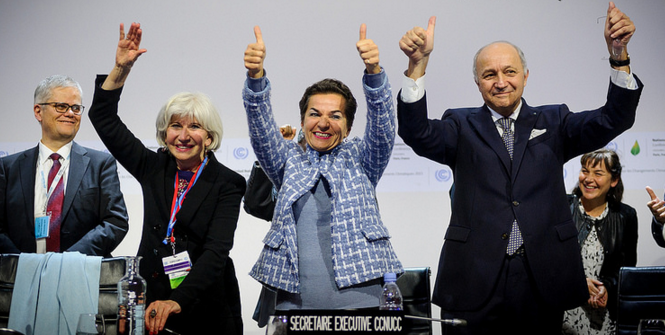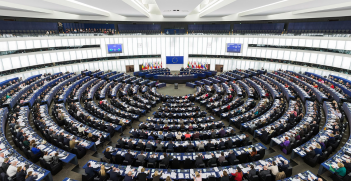Climate Change: The Paris Honeymoon Ends

The past week will shape climate action for the decade to come and whether the world will stay within the 2°C goal will come back to the events of November 2016. It means that the 22nd session of the Conference of Parties in Morocco has marked the end of the Paris honeymoon.
The timeline of the Paris Agreement on global climate governance could easily be read: conceived on 12 December 2015, born on 4 November 2016 and deceased on 9 November 2016. The Paris Agreement has both entered force and possibly become doomed with the election of a US leader who has threatened to “cancel” it.
It is against this tumultuous background that in-depth climate negotiations have been taking place in Marrakech, Morocco as part of COP22.
The Paris Honeymoon
Since its adoption at COP21 last year, the Paris Agreement has been hailed as “historic”, a “breakthrough”, and a “watershed” agreement. A deal that finally managed to have all major emitters put forward commitments to cut emissions.
Much of the reaction was premature and shallow. It overlooked the lack of historical precedent for the Paris structure and the weakness in its substance. Yet it shaped a jubilant public response. There was widespread confidence and renewed optimism in international efforts. Regardless of detail the agreement was in a honeymoon phase of appreciation.
The celebration continued as the agreement rapidly entered into force. It took the deal less than one year to become legally operational, a feat which took the Kyoto seven. Indeed, even (as of yesterday) the Australian government has ratified the agreement.
The ratification of the Paris Agreement by Australia should come as no surprise. Paris implies few legal obligations beyond submitting a progressively stronger target every five years. It is a cycle that Australia has already been largely practicing. In 2015, the Australian government submitted its intended nationally determined contribution (INDC), in 2009 it created a pledge under the Copenhagen accord, and in 2007 it agreed to a target under the Kyoto Protocol. Paris was just a legal ribbon around what Australia and many other parties had been doing for the past two decades: engaging in a global show and tell.
Failure to ratify would mean unnecessarily becoming an international pariah. There was never any real debate to be had in Australia over ratification.
The ratification avalanche had triggered further confidence in the agreement.
This was bound to be challenged as negotiations in Morocco began. The Paris Agreement is a loose skeleton, with much of the detail to be determined. The missing detail included what countries would need to include in their pledges, how the review process would work, how to ensure transparency in actions and how exactly market mechanisms such as emissions trading would function under the agreement.
The devil is in the detail and each of these matters is critical to Paris succeeding as a framework. The negotiations were bound to slow. At this stage, much of the discussion on each idea was ‘high-level’ focusing on general principles and answering fundamental questions.
The negotiations on these details were stalled on the opening day when Turkey threw up a procedural hurdle, refusing to allow for negotiations to continue before its request to be allowed financing under the climate agreement had been considered. Unfortunately, it was not the final spanner to be thrown into the Paris work during the week.
The Trump Card
The US election was always going to be a bigger event for international climate action than COP22.
The Paris Agreement was built around allowing for US participation. It traded off binding emissions reductions targets and financial commitments to allow for easy adoption through an executive agreement by Obama. It sacrificed depth for US participation. The design seemed clever last year. Now it has been exposed as short-sighted and reckless.
President-elect Trump can and likely will withdraw the US from the Paris Climate Agreement. This would take 4 years if done just for the Paris Agreement. But withdrawing from the overarching UN climate negotiations would only take one year and result in automatic withdrawal from Paris.
Alongside this he appears set to pull all funding from UN climate instruments and enact a series of sweeping energy reforms aimed at promoting fossil fuel development.
The news was greeted with a stunned reaction at the conference. It was a mixture of numbed defiance and despair. Youth wept and protested passionately. Veteran campaigners scrambled to reassure the press that the Paris Agreement would survive.
In the negotiating rooms the election result was barely mentioned. It is diplomatic etiquette to avoid discussing the domestic politics of other UN members and the UN bubble was thoroughly maintained despite the chaos in the news. Some delegations did use the opportunity to begin to cast the seeds of doubt. The Saudi Arabian negotiators have apparently already been informing other delegations that the Paris Agreement is dead and countries should simply stick with the original climate convention.
The election result is unlikely to trigger further ambition or good faith in future negotiations. Regardless of what Trump does, the negotiations on the details just became significantly harder. Without the right details in place the already weak system of Paris will become redundant: riddled with ambiguities and loopholes.
The risky bargain that the agreement was built on has been undone. The loss of a superpower will likely be fatal for an agreement that is still under construction.
Luke Kemp is a lecturer in climate and environmental policy at both the Fenner School of Environment and Society and Crawford School of Public Policy. He has been attending COP22 in Marrakech this week.
This article is published under a Creative Commons License and may be republished with attribution.





